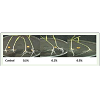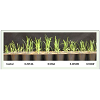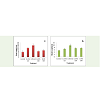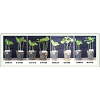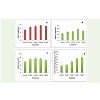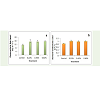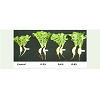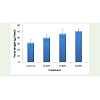Bio Stimulant Activity of Protein Hydrolysate: Influence on Plant Growth and Yield
Sindhu B Subbarao, I S Aftab Hussain* and Prasad T Ganesh
Corresponding author: Dr. I S Aftab Hussain, Department of Crop Physiology, University of Agricultural Sciences,GKVK, Bangalore: 560065, Ph: +91 9845426147, India; E-mail: aaftab55@gmail.com
Department of Crop Physiology, University of Agricultural Sciences, GKVK, Bangalore: 560065, India
Citation: Subbarao SB, Aftab Hussain IS, Ganesh PT. Bio Stimulant Activity of Protein Hydrolysate: Influence on Plant Growth and Yield. J Plant Sci Res. 2015;2(2): 125.
Copyright © 2015 I S Aftab Hussain et al. This is an open access article distributed under the Creative Commons Attribution License, which permits unrestricted use, distribution, and reproduction in any medium, provided the original work is properly cited.
Journal of Plant Science & Research | ISSN: 2349-2805 | Volume: 2, Issue: 2
Submission: 09/06/2015; Accepted: 07/07/2015; Published: 13/07/2015
Abstract
Fertilization practices and growing techniques play a major role in influencing plant productivity. Fertilizers which have minimum impact on the environment are gaining popularity. In this regard, organic bio-stimulants such as protein hydrolysates, humates, etc., are becoming popular, as they reduce the use of chemical fertilizer by up to fifty percent. In this study, we focus on the influence of protein hydrolysate of animal origin on growth and productivity of different crop plants. We observed a positive effect of protein hydrolysate on plant growth and yield across crop species. Both soil and foliar treatments had a higher impact on the initial plant growth compared to control; however, soil application was more effective than foliar application. All parameters recorded including root and shoot length, leaf area, total chlorophyll content, photosynthetic rate, and yield were greater in treated plants. We report here that, protein hydrolysate when supplemented through soil, positively influences plant growth and metabolism; thereby, contributing towards higher crop yields. Hence, protein hydrolysates can be effectively used as organic fertilizers to improve productivity of the crops.
Keywords: Bio-stimulant; Protein hydrolysate; Amino acids; Peptide; Growth; Yield
Introduction
Bio-stimulants are considered to be a group of substances known to have profound effect on the growth and development of plants.Zhang and Schmidt [1] first defined bio-stimulants as “materials thatin minute quantities, promote plant growth”. Many other definitionshave evolved over time and each of them emphasize on differentroles of these bio-stimulants. About 60 different substances havebeen grouped under the label of bio-stimulants [2]. A bibliographicanalysis has been conducted by du Jardin [3] on eight categories ofbio-stimulants such as humic substances, complex organic materials,beneficial chemical elements, inorganic salts including phosphite,sea weed extracts, chitin and chitosan derivatives, anti-transpirants,hormone containing products, amino acids, peptides, and otherN-containing substances.
Bio-stimulants can be made available to plants through foliarsprays or through soil application. Foliar applied bio-stimulants were shown to reach mesophyll cells by absorption through cuticle andepidermal cells [4-6]. When supplied through soil, the absorptionoccurs through root epidermal cells and gets redistributed throughxylem [7]. These formulations decrease the need of chemical fertilizersand have the capacity to satisfy the nutritional requirements of plantsand also further result in higher yield [8].
Formulations containing amino acids, peptides, polyamines,and betaines were found to have plant growth stimulation activity.These compounds have come into scrutiny for their stimulatory effectwhich is distinct from the effect of additional nitrogen source [9,10].Amino acids can easily be absorbed by plant roots and through foliage[11,12]. They have the capacity to enhance nitrogen use efficiency ofthe plants and further stimulate photosynthesis and plant growth[13]. Their effects on carbon and nitrogen metabolism, and plantprimary and secondary metabolism have been reported by Schiavonet al. [14] and Maini [15]. Hormone-like-activity including Auxin-like-activity and Gibberellin-like-activity has also been attributed to amino acids and peptides [14].
Protein hydrolysates containing amino acids and peptides can beof either plant or animal origin. They are manufactured by chemicalor enzymatic hydrolysis of plant residues or animal connectivetissues [10,16-19]. The primary aim of this paper is to describe thephysiological effect of amino acids and peptides, collectively calledprotein hydrolysate, on plant growth processes and crop yield.
Materials and Methods
Experiments were conducted to evaluate the role of an animalbased protein hydrolysate, on early seedling growth in crop speciessuch as Paddy, Finger millet, Cowpea and in Radish, where yield wasalso recorded. Protein hydrolysate used in this study was supplied byISAGRO Asia Agro Chemicals Pvt. Ltd, Mumbai, India; with the tradename of Siapton 10L. The chemical composition of the concentratedformulation is given by Parrado et al. [13] and Mladenova et al. [20].
Seedling Growth in Paddy
CleriGel 1% (HiMedia Laboratories Pvt. Ltd, Mumbai, India)containing 0.1%, 0.2% and 0.5% (v/v) protein hydrolysate formulationwas prepared and poured into test tubes. Rice seeds (CV: MTU1010) were germinated on sterile water. Germinated seeds havingtwo mm radical length were placed on CleriGel containing differentconcentrations of protein hydrolysate. The test tubes were incubatedin dark for seven days. Root and shoot length were measured afterseven days.
Seedling Growth in Finger millet
Seeds of Finger millet genotype GPU 28 were sown in nurserytrays filled with red soil and Farm Yard Manure (FYM) in the ratio of1:1. Nine days after sowing the plants were thinned to five seedlingsper cup. Protein hydrolysate was supplied at two concentrations,0.25% and 0.5%, either as a foliar treatment or via soil application.Foliar application was done by smearing protein hydrolysate solutionto both upper and lower surfaces of the leaf using cotton swabs. Forsoil application, 5ml of the solution was applied per 100g of dry soil.Seven days after application root and shoot lengths were measured.
Seedling growth and photosynthesis in Cowpea
Seeds of Cowpea genotype C-152 were germinated on sterilewater. Germinated seeds with two mm radical length were plantedin pots containing 500g of soil and FYM mix. Nine days aftergermination, five plants were maintained in each pot and 20 ml ofprotein hydrolysate was supplied to each pot. Four concentrations ofprotein hydrolysate, viz 0.2%, 0.4%, 0.6%, and 0.8%, were used for thestudy. Influence of protein hydrolysate application on root and shootgrowth, leaf area and total chlorophyll was studied seven days aftersoil application.
Cowpea plants raised in containers with soil and FYM mixture1:1 (w/w) were treated with protein hydrolysate by applying 20 mlsolution per pot. Seven days after soil application, observations onphotosynthetic rate and stomatal conductance were recorded using aportable photosynthetic system (LICOR LI-6400).
Productivity in Radish
Radish seedlings were raised in pots containing 13 kg of soiland FYM mixture. Two plants were maintained per pot. Plants wereirrigated every day to bring the water status to field capacity. Whenplants were 30 days old, 150 ml of 0.2%, 0.4%, and 0.6% proteinhydrolysate was applied to the soil. Plants were harvested on 60th dayof planting and fresh weight of Radish was recorded.
Results
Seedling growth in Paddy and Finger Millet
Paddy: Seedlings grown on CleriGel-protein hydrolysatemedium showed increased root and shoot length. Presence of proteinhydrolysate in the rooting medium resulted in significant increase inroot and shoot length, both increasing with increasing concentrationof protein hydrolysate. The effect observed was greater in root length,which showed an increase of 1.3 times over control. (Figure 1, Figure 5a,b)
Figure 1: Root and Shoot growth of nine day old Rice seedlings grown in test tubes over CleriGel media incorporated with various concentrationsSiapton 10L.
Figure 5: Root (a) and Shoot (b) length of nine day old Rice seedlings grown on 1% CleriGel incorporated with different concentrations of Siapton 10L.
Finger millet: The root and shoot growth increased withincreasing concentration of protein hydrolysate up to 0.5%. Themaximum increase in shoot and root length was seen when proteinhydrolysate was applied to soil. The increase in root and shoot lengthwas to the extent of 126% and 79% at 0.5% soil application; and 30% and 38% at 0.5% foliar application respectively when compared tocontrol. (Figure 2, Figure 6a,6b)
Figure 2: Response of nine day old Finger millet seedling to differentconcentrations of Siapton 10L (SA: Soil Application, SW: Foliar Application).
Figure 6: Root (a) and Shoot (b) length of Finger millet seedlings treated with Siapton 10L. Observations were recorded seven days after treatment to nine dayold seedlings. (SA: Soil Application, SW: Foliar Application).
Growth parameters in Cowpea
Protein hydrolysate treatment was effective in increasing rootgrowth, shoot growth and leaf area in Cowpea. Root and shootlength of seedlings increased with increase in protein hydrolysateconcentration up to 0.6% (Figure 7a,b). Leaf area of Cowpea seedlings increased linearly up to 0.4% protein hydrolysateconcentration. (Figure 7c). Application of protein hydrolysate alsoresulted in early development of trifoliate leaves in the seedlings.(Figure 3).
Figure 3: Response of Cowpea seedlings supplemented with 0.2% 0.4%, 0.6% and 0.8% Siapton 10L through soil application (SA). Observationswere recorded seven days after treatment to nine day old seedlings.
Figure 7: Response of Cowpea seedlings to Siapton 10L: Nine day old Cowpea seedlings were treated with 0.2%, 0.4%, 0.6%, and 0.8% Siapton 10L throughsoil application.Root length (a), shoot length (b), leaf area (c) and total chlorophyll content (d) were recorded seven days after treatment.
The chlorophyll pigment concentration was determined in thecotyledonary leaves of Cowpea seedlings. The results show thatchlorophyll content increased with increase in concentration ofprotein hydrolysate up to 0.8%. (Figure 7d).
Photosynthetic Rate in Cowpea
Seedlings treated with protein hydrolysate showed significantincrease in photosynthetic rate as well as stomatal conductance. Soilapplication of protein hydrolysate increased photosynthetic rate by35.1% over control and stomatal conductance increased by 21.7%over control. (Figure 8a,b).
Productivity in Radish
Application of protein hydrolysate to the soil resulted in significantincrease in fresh weight of Radish. The increase was to an extent of26%, 46%, and 60% with 0.2%, 0.4%, and 0.6% protein hydrolysatetreatments respectively when compared to control. (Figure 4 and Figure 9).
Figure 4: Yield of Radish plants treated with 0.2%, 0.4%, and 0.6% Siapton 10L thirty days after sowing.
Figure 9: Root (a) and Shoot (b) length of nine day old Rice seedlings grown on 1% CleriGel incorporated with different concentrations of Siapton 10L.
Discussion
Protein hydrolysates containing amino acids and peptides areknown to have bio-stimulant like activity. Karnoc [2] has listed aminoacids and peptides to be among the constituents of bio-stimulantformulations. Peptides which are absorbed by plants are hydrolysedby various peptidases to the constituent amino acids which can beused as an alternative source of nitrogen and carbon or also used forprotein synthesis [21,22]. Studies have indicated that amino acidsand proteins may have a role in nitrogen acquisition [23-25]. Aminoacids increase the plant efficiency by instigation of metabolism andmetabolic processes [26].
The influence of protein hydrolysate on seedling growth wasstudied in crops such as Paddy, Finger millet, Cowpea and Radish.The results clearly show that protein hydrolysate applicationstimulates root and shoot growth in all the crops tested. The effecton root growth was substantially greater than that on the shootgrowth. Studies conducted with Cowpea showed that soil applicationimproves photosynthetic surface area to the extent of 30%. Increasein root length would influence higher uptake of water as well asnutrients from the soil leading to higher growth rate throughhigher photosynthetic surface area. Observations on gas exchangeparameters also indicated a significant increase in photosyntheticrate as well as stomatal conductance. These observations clearly provethat increase in total canopy photosynthesis by virtue of increasedleaf area, increased carbon assimilation rate per unit leaf area.Increased availability of photosynthates resulted in increased plantheight and root length. As an extrapolation of work done in Cowpea,further experiments conducted with Radish in containers proved that0.6% protein hydrolysate soil application one month after plantingimproved productivity by 59.56%. These results substantiate theimproved photosynthetic activity and nutrient absorption by theroots which is reflected in terms of stimulated growth and increase inharvestable yield of Radish.
Since the protein hydrolysate used is known to contain free aminoacids and low molecular weight short peptides, we assume that these amino acids serve as immediate organic nitrogen source for synthesisof other macromolecules as previously reported [27-30]. In additionto amino acids, short peptides serve as a source of nitrogen nutritionwhich immediately advances plant metabolism.
Our experiments demonstrate the importance of application ofprotein hydrolysate in improving plant growth. We conclude thatprotein hydrolysate formulations can be used as biostimulants orbio-fertilizers to achieve higher yields in crop plants. The proteinhydrolysate used in this study was, Siapton 10L, a commercialformulation obtained from hydrolysis of skin and hair wastes [13].It is known to contain various amino acids and short chain peptides[20].
Acknowledgement
Authors gratefully acknowledge the financial support andthe product provided by ISAGRO Asia Agro Chemicals Pvt. Ltd,Mumbai, India.
References
- Zhang X, Schmidt RE (1999) Biostimulating turf-grasses. Grounds Maintenance 34: 14-32.
- Karnok KJ (2000) Promises, promises: can biostimulants deliver? Golf Course Management 68: 67-71.
- Jardin P (2012) The science of plant biostimulants-a biblio-graphic analysis. Contract 30-CE0455515/00-96, adhocstudy on bio-stimulants products.
- Fernández V, Brown PH (2013) From plant surface to plant metabolism: the uncertain fate of foliar applied nutrients. Front Plant Sci 4: 289.
- Fernández V, Eichert T (2009) Uptake of hydrophilic solutes through plant leaves: current state of knowledge and perspectives of foliar fertilization. Crit Rev Plant Sci 28: 36-68.
- Riederer M, Friedmann A (2006) Transport of lipophilic non-electrolytes across the cuticle.In: Riederer M, Muller C, eds. Biology of the plant cuticle. Oxford: Blackwell Publishing, 249-278.
- Chen CC (1963) The absorption and mobility of root and foliar applied Calcium, Sulphur, Zinc, and Iron by Tomato seedlings as influence by Gibberllin treatments. Botanical Bullentin of Academia Sinica 5: 17-25.
- Tejada M, Gonzalez JL (2004) Effects of application of a byproduct of the two-step olive oil mill process on maizeyield. Agron J 96: 692-699.
- Calvo P, Nelson L, Kloepper JW (2014) Agricultural uses of plant biostimulants. Plant and Soil 383: 3-41.
- Ertani A, Cavani L, Pizzeghello D, Brandellero E, Altissimo A, et al. (2009) Biostimulant activity of two protein hydrolyzates in the growth and nitrogen metabolism of maize seedlings. J Plant Nutri Soil Sci 172: 237-244.
- Nacry P, Bouguyon E, Gojon A (2013) Nitrogen acquisition by roots: physiological and developmental mechanisms ensuring plant adaptation to a fluctuating resource. Plant Soil 370: 1-29.
- Stiegler JC, Richardson MD, Karcher DE, Roberts TL, Norman RJ (2013) Foliar absorption of various inorganic and organic nitrogen sources by creeping bentgrass. Crop Sci 52: 1148-1152.
- Parrado J, Bautista J, Romero EF, Garcı´a-Martı´nez AM, Friaza V, et al. (2008) Production of a carob enzymatic extract: Potential use as a biofertilizer. BioresourTechnol 99: 2312-2318.
- Schiavon M, Ertani A, Nardi S (2008) Effects of an alfalfa protein hydrolysate on the gene expression and activity of enzymes of the tricarboxylic acid (TCA) cycle and nitrogen metabolism in Zea mays L. J Agric Food Chem 56: 11800-11808.
- Maini P (2006) The experience of the first biostimulant, based on amino acids and peptides: a short retrospective review on the laboratory researches and the practical results. Fertilitas Agrorum 1: 29-43.
- Cavani L, Halle AT, Richard C, Ciavatta C (2006) Photosensitizing properties of protein hydrolysate based fertilizers. J Agric Food Chem 54: 9160-9167.
- Ertani A, Pizzeghelio D, Altissimo A, Nardi S (2013) Use of meat hydrolyzate derived from tanning residues as plant biostimulant for hydroponically grown maize. J Plant Nutr Soil Sci 176: 287-296.
- Grabowska A, Kunicki E, Sekara A, Kalisz A, Wojciechowska R (2012) The effect of cultivar and biostimulant treatment on the carrot yield and its quality. Veg Crops Res Bull 77: 37-48.
- Kauffman GL, Kneival DP, Watschke TL (2007) Effects of biostimulant on the heat tolerance associated with photosythetic capacity, membrane thermostability, and polphenol production of perennial ryegrass. Crop Sci 47: 261-267.
- Mladenova YI, Maini P, Mallegni C, Goltsev V, Vladova R, et al. (1998) Siapton- An amino-acid-based biostimulant reducing osmostress metabolic changes in Maize. Agro Food Industry Hi-Tech 9: 18-22.
- Perry JR, Basrai MA, Steiner H, Naider F, Becker JM (1994) Isolation and characterization of a Saccharomyces cerevisiae peptide transport gene. Mol Cell Biol 14: 104-115.
- Steiner HY, Naider F, Becker JM (1995) The PTR family: A new group of peptide transporters. Mol Microbiol 16: 825-834.
- Chapin III FS, Moilanen L, Kielland K (1993) Preferential use of organic acid N by a non-mycorrhizal arctic sedge. Nature 361: 150-153.
- Fan X, Gordon-Weeks R, Shen Q, Miller AJ (2006) Glutamine transport and feedback regulation of nitrate reductase activity in barley roots leads to changes in cytosolic nitrate pools. J Exp Bot 57: 1333-1340.
- Miller AJ, Fan X, Orsel M, Smith SJ, Wells DM (2007) Nitrate transport and signalling. Journal of Experimental Botany 58: 2297-2306.
- Starck Z (2007) Growing asistant: Aplication of growth regulators and biostimulators in modern plant cultivation (in Polish). Rolnik Dzierawca 2: 74-76.
- El-Naggar A, de Neergaard A, El-Araby A, Høgh-Jensen H (2009) Simultaneous Uptake of Multiple Amino Acids by Wheat. J Plant Nutr 32: 725-740.
- Gioseffi E, de Neergaard A, Schjoerring JK (2012) Interactions between uptake of amino acids and inorganic nitrogen in wheat plants. Biogeosciences 9: 1509-1518.
- Hill PW, Farrar J, Roberts P, Farrell M, Grant H, et al. (2011) Vascular plant success in a warming Antarctic may be due to efficient nitrogen acquisition. Nature Clim Change 1: 50-53.
- Knut Kielland (1994) Amino Acid Absorption by Arctic Plants: Implications for Plant Nutrition and Nitrogen Cycling. Ecology 75: 2373-2383.

